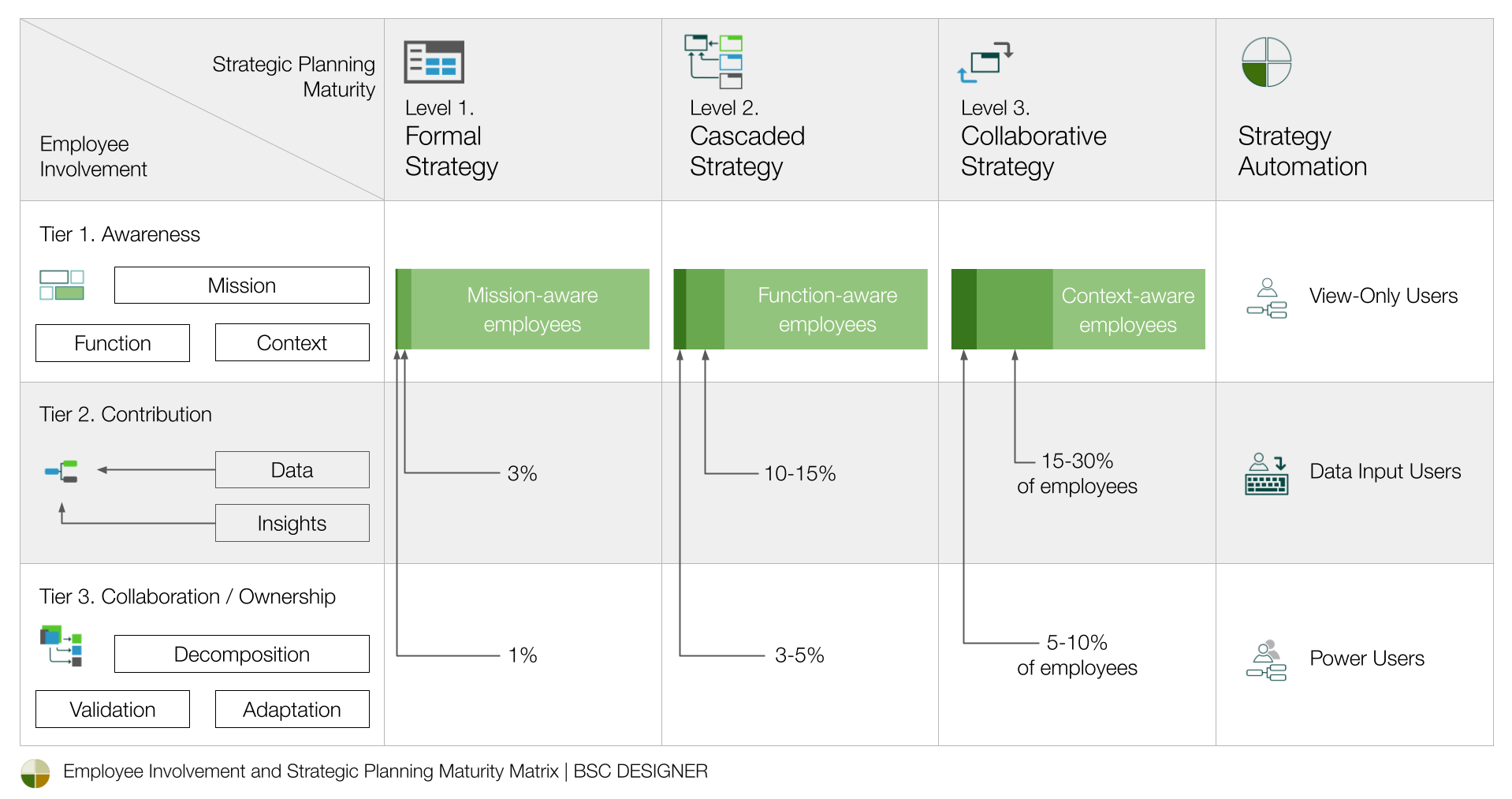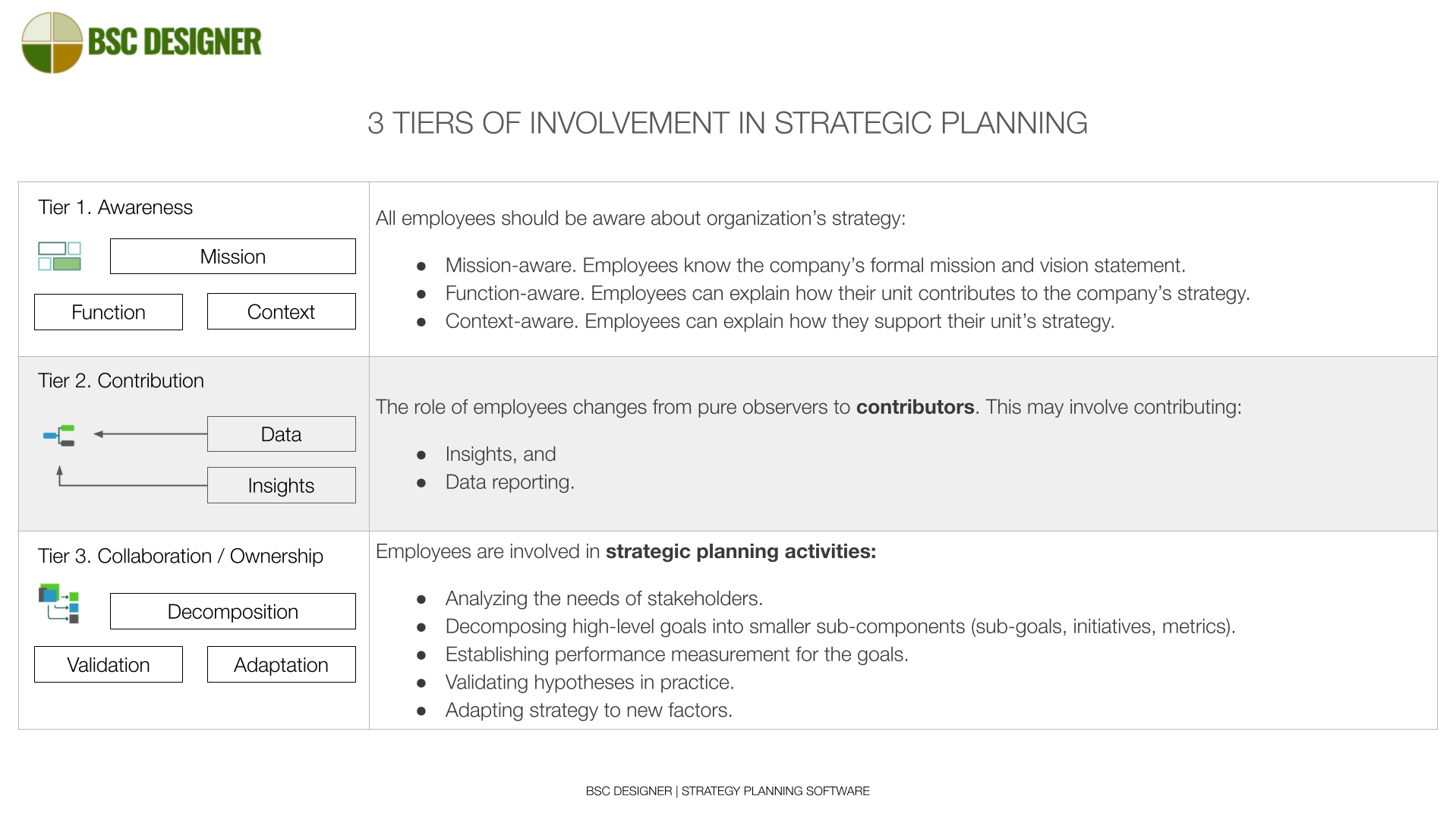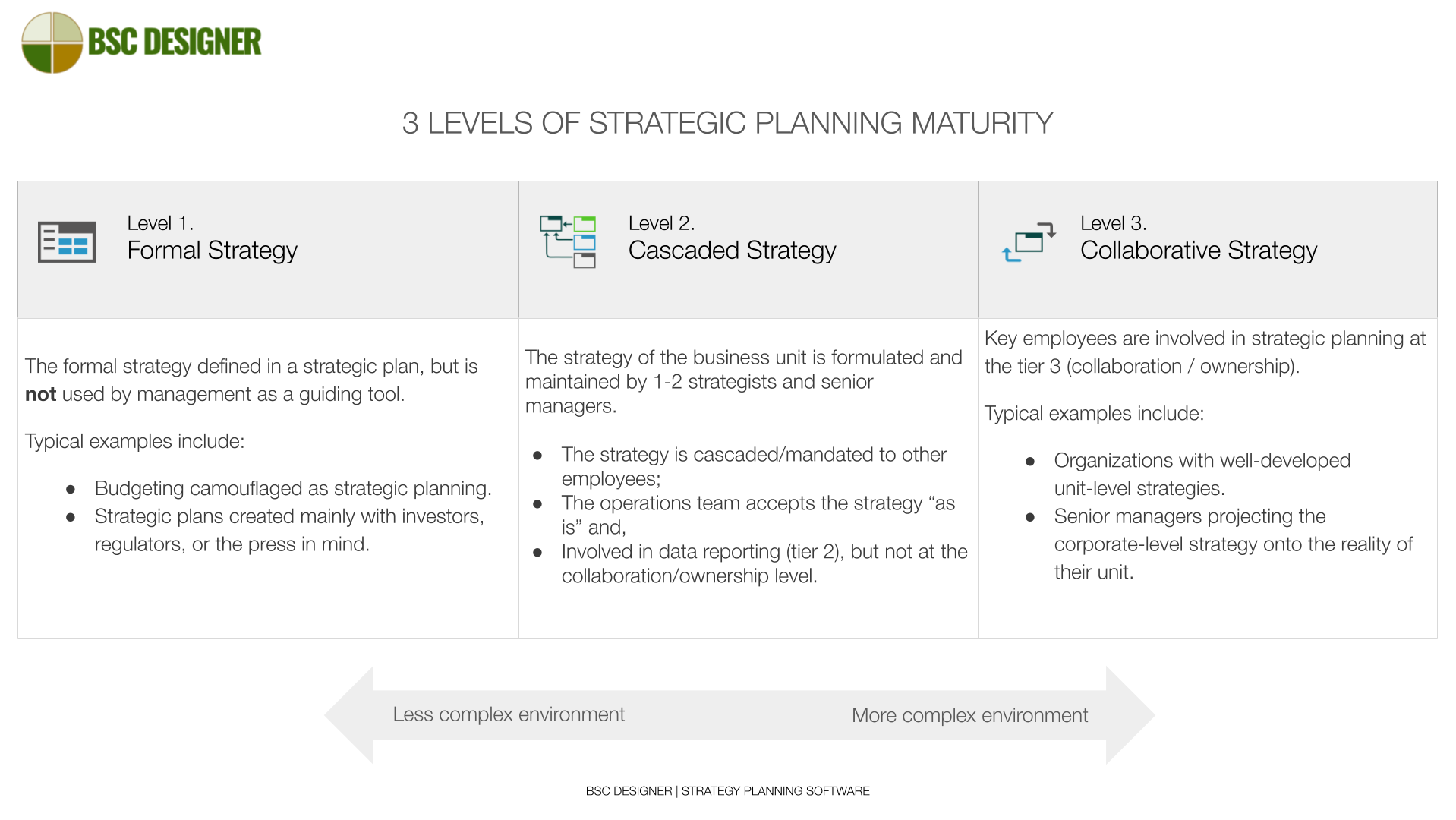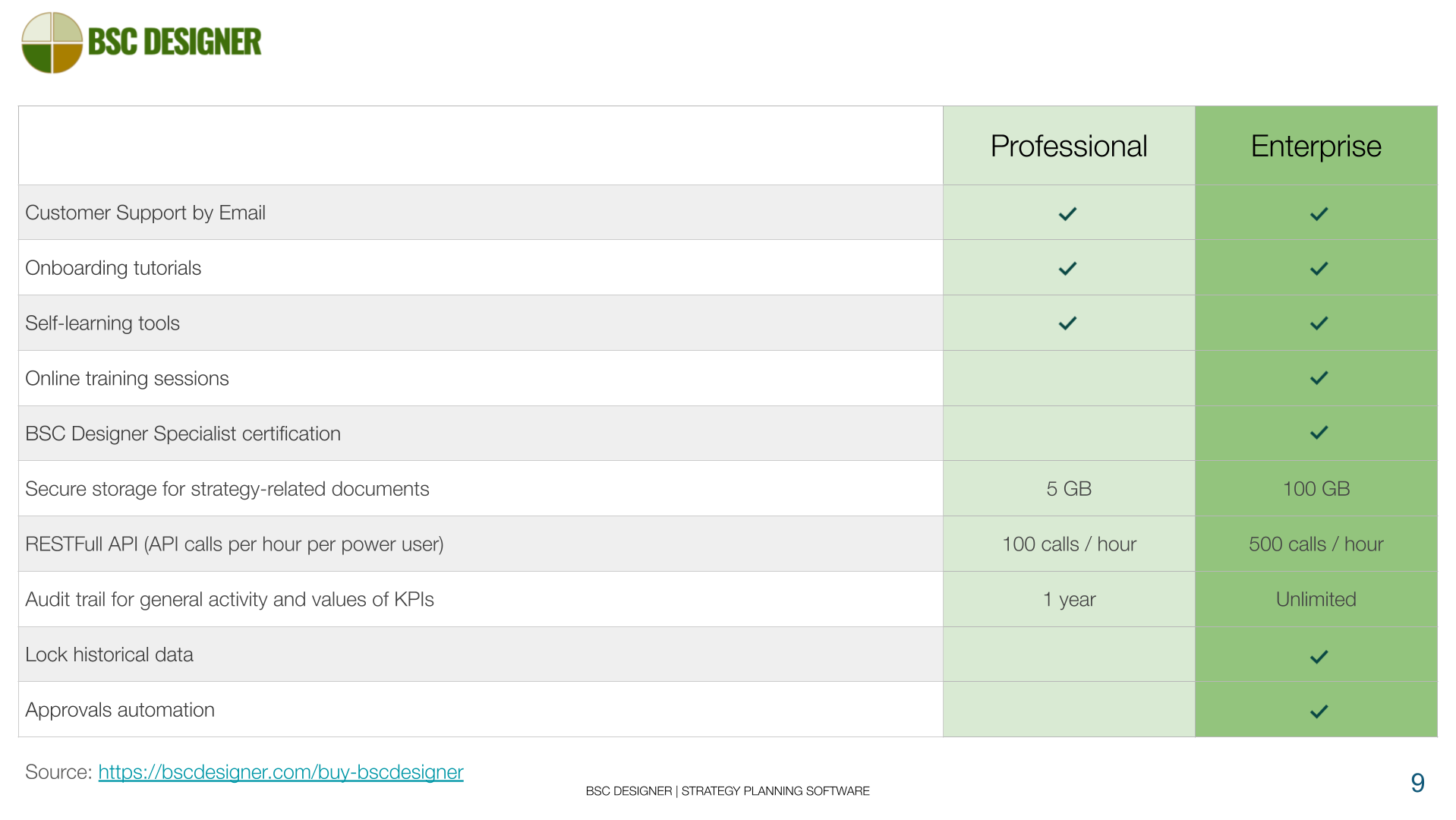Understanding employee involvement in strategic planning and its effect on an organization’s strategy-related practices.

They say that “strategy should be everyone’s job” – that’s true for strategy execution in general, but what about strategy development? Who is responsible? Who needs to be involved? What kind of involvement are we talking about?
This article will help strategists to:
- Define the tiers of employee involvement in strategic planning
- Self-assess the current maturity level of their organization
- Orchestrating strategic planning – the Office of Strategy Management
- Presentation slides
As a vendor of strategic planning software, we also aim to guide our prospective customers in their efforts to improve the strategic planning process and acquire an appropriate number of subscriptions for BSC Designer software.
3 Tiers of Involvement in Strategic Planning
We often hear that employees need to be involved in strategy. It’s worth defining the meaning of “involvement” in the context of strategic planning. Below, we’ll discuss the three tiers of involvement and share examples of how this involvement looks in practice.

Tier 1. Strategy Awareness
When we ask “Who should be involved in strategic planning” and hear the answer “Everyone!”, we are talking about involvement in the sense of strategy awareness.
A strategy has more chances for successful execution if people who are working on it have a general understanding of the strategic context of their responsibilities.
How can we test this understanding? We discussed this in a previous article. Here, we can define three sub-tiers of strategy awareness:
- Mission-aware. Employees know the company’s formal mission and vision statement.
- Function-aware. Employees can explain how their unit contributes to the company’s strategy.
- Context-aware. Employees can explain how they support their unit’s strategy.
In BSC Designer software, users with view-only access to the strategy can be considered as employees at the strategy awareness tier.
Best practices for strategy awareness include:
- Using mission, vision, and values widgets on the global dashboard available to all users of the account.
- Sharing links to the relevant maps and dashboards in internal communications to encourage users to review the latest changes.
- Practicing strategy on a page presentations.
Tier 2. Contribution
Here, the role of employees changes from pure observers to contributors. This may involve contributing:
- insights, and
- data reporting.
For example, in addition to having access to a general strategy map (awareness tier), contributors might have access to specific goals and indicators. They can see how their contributions impact their unit’s strategy.
In BSC Designer, data input users can be considered as employees at the contribution tier, as they report their data directly to the performance indicators and can add their comments to the data reported to KPIs.
Tier 3. Collaboration / Ownership
On this tier, employees are involved in typical strategic planning activities such as:
- Analyzing the needs of stakeholders and converting them into high-level goals.
- Decomposing high-level goals into smaller sub-components (sub-goals, initiatives, metrics).
- Establishing performance measurement for the goals (measurement method, regularity, aggregation type, owners).
- Conducting risk analysis and defining risk metrics in the context of goals.
- Defining action plans and initiatives.
- Validating hypotheses in practice.
- Adapting strategy to new factors.
In BSC Designer, Power Users are at the collaboration / ownership tier.
Assessing Strategic Planning Approaches Across Business Units
With the levels of employee involvement in mind, we can estimate where specific business units are in terms of their approach to strategic planning.

Level 1. Formal Strategy
In such business units, the strategy is a formality that needs to be reported at annual meetings. It is not a tool that is regularly used to support business decisions. The formal strategy might be defined in a strategic plan, but it is not used by management as a guiding tool.
Typical examples include:
- Budgeting camouflaged as strategic planning.
- Strategic plans created mainly with investors, regulators, or the press in mind.
Estimated number of employees involved in strategic planning:
- 1% involved at the collaboration/ownership tier.
- 2-3% involved at the contribution tier.
- Strategy awareness of other employees: mission-aware tier.
Level 2. Cascaded Strategy
In this level, the strategy of the business unit is formulated and maintained by 1-2 strategists and senior managers. The know-how about the strategy remains with a few strategists. The strategy is cascaded/mandated to other employees; the operations team accepts the strategy as is and, in the best case, is involved in data reporting, but not at the collaboration/ownership level.
Typical examples include:
- Organizations with established corporate-level strategy defined by the CEO and executive team.
- Organizations with a dedicated strategic planning unit that establishes metrics and targets for other business and functional units.
Estimated number of employees involved in strategic planning:
- 3-5% involved at the collaboration/ownership tier.
- 10-15% involved at the contribution tier.
- Strategy awareness of other employees: function-aware tier.
Level 3. Collaborative Strategy
On this level, key employees are involved in strategic planning at the collaboration / ownership tier. They work with strategic hypotheses, formulate business goals, initiatives, track KPIs, etc.
Typical examples include:
- Organizations with well-developed unit-level strategies.
- Senior managers projecting the corporate-level strategy onto the reality of their unit.
Estimated number of employees involved in strategic planning:
- 5-10% involved at the collaboration/ownership tier.
- 15-30% involved at the contribution tier.
- Strategy awareness of other employees: context-aware tier.
Orchestrating Strategic Planning – The Office of Strategy Management
Strategic planning is not homogeneous across the organization.
When scaling up business or functional units into departments, divisions, etc., we will see that the maturity level of strategic planning fluctuates.
We need to focus on:
- Establishing standards for strategy development,
- Sharing best practices, and
- Communicating strategy across units.
The role of the Office of Strategy Management (OSM) emerges in this context.
Think about various business units within organizations working on their own strategy scorecards. All with their approach to strategic planning, data collection, reporting, differences in terminology, and various theoretical backgrounds:
- The corporate-level strategy might be well-developed.
- The strategy of some business units might be detailed but miss alignment with the overall strategy.
- The strategy of another functional unit might use risk measurement methods that are not compatible with methods accepted by other units.
With the growing complexity of the organization, the need for an internal regulator or orchestrating role emerges.
The Office of Strategy Management concept was introduced by Robert S. Kaplan and David P. Norton in their HBR article in 2005, articulating among its functions:
- Establishing a shared process of scorecard development.
- Overseeing data collection, validation, integrity, and reporting.
- Standardizing terminology.
- Providing scorecard training and education.
- Aligning scorecards across the organization.
- Communicating strategy.
BSC Designer software will help oversee and standardize the strategic planning process by defining shared templates for:
- Performance formulas.
- Dashboard layout.
- KPI setup.
- Scorecard templates.
The tool will also support OSM in:
- Maintaining data consistency via controlled actualization intervals.
- Automating alignment.
- Automating strategy communication via scheduled reports.
Strategic Planning Unit vs. Office of Strategy Management
What’s the difference between the idea of a Strategic Planning Unit and the Office of Strategy Management?
Metaphorically speaking, if the strategic planning unit is a concertmaster or first violin, then the office of strategy management is the orchestra conductor…
When discussing the strategic planning unit and the office of strategy management, we are actually talking about two different roles:
- High-level strategy development, and
- Internal regulator/orchestrator role
For smaller companies, there is no need for an office of strategy management; its role is played by the strategic planning unit. However, with the growth of scale and complexity of organizations, the need for overseeing the process of scorecard development emerges.
Video Tutorial
Slides








- Access the slides for the ‘Strategic Planning: Who is Responsible and Who Needs to be Involved?’
Takeaways
We defined three tiers of employee involvement in strategic planning:
- Tier 1. Strategy awareness (with three sub-tiers: mission-aware, function-aware, and context-aware)
- Tier 2. Contribution
- Tier 3. Collaboration / ownership
Scaling up to the organizational level, the extent of employee involvement in strategy defines the company’s approach to strategic planning:
- Level 1. Formal Strategy – limited to annual strategic planning
- Level 2. Cascaded Strategy with established centralized strategic planning
- Level 3. Collaborative Strategy suggested as the best practice to follow
The “Collaborative Strategy” level refers to:
- 100% of employees involved at the awareness tier
- 15-30% of employees involved at the contribution tier
- 5-10% of employees involved at the collaboration / ownership tier
As for practical guidance during the procurement of strategic planning software, the same model can be used as an estimation for the number of users:
- 100% of employees having access as view-only users (awareness tier) – “view-only users” in BSC Designer
- 15-30% of employees having access as data input users (contribution tier) – “data input users” in BSC Designer
- 5-10% of employees having access as power users (collaboration / ownership tier) – “power users” in BSC Designer
Feel free to share your observations about the mentioned maturing models in your organization in the comments for the article.
BSC Designer is strategy execution software that enhances strategy formulation and execution through tangible KPIs. Our proprietary strategy implementation system reflects our practical experience in the strategy domain.